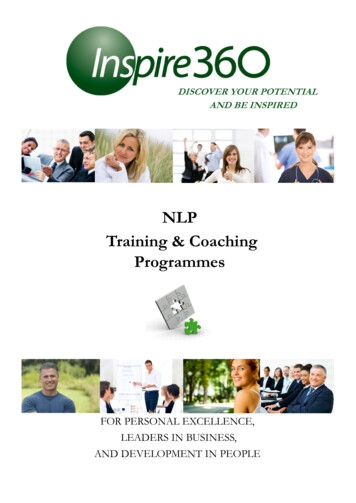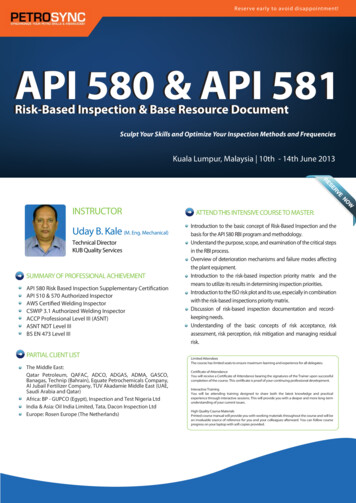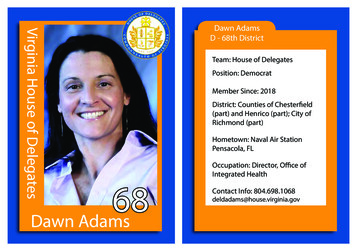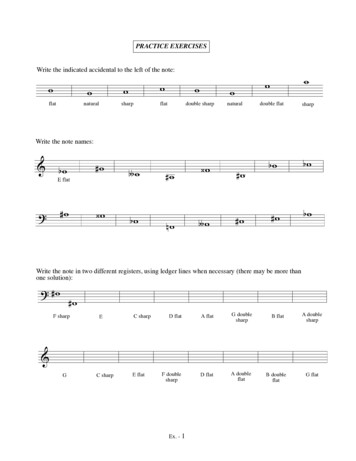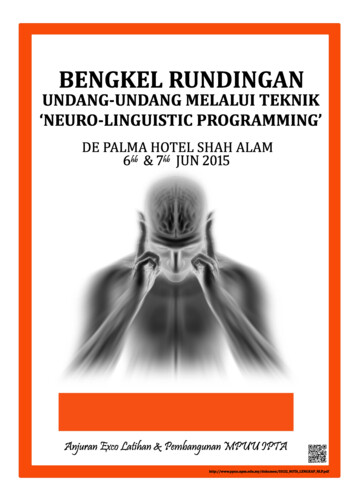
Transcription
NOTES FOR DELEGATESTHE SECRETARIATThe Secretariat is located at the back side of Dewan Anggerik. Secretariat Desk willbe opened and staffed on Saturday, 6th June 2015 at 8.00am – 10.30pm; and onSunday, 7th June 2015 at 8.15am–1.00pm. Alternatively, you may call Pn. Nariza at012-3787681 for assistance.VENUE OF WORKSHOPThe Workshop will take place at DEWAN ANGGERIK, GROUND FLOOR of the DEPALMA HOTEL, SHAH ALAM.PROCEEDING MANAGEMENTPlease be seated at least 5 minutes before each session commences to minimizedisruption to the proceeding.QUESTIONS & ANSWERS SESSIONAll questions pertaining to the session will be taken at the end of particular sessionor may be arranged by the speakers in that session. Kindly identify yourself, i.e.your name and institution name, before asking questions.BREAKFAST, LUNCH, DINNER & REFRESHMENT BREAKSBreakfast, lunch and dinner and will be provided at RUMBIA COFFEE HOUSE,GROUND FLOOR while refreshment during breaks will be provided outside theworkshop room. Please take note that for all individual beverages ordered duringmealtimes than otherwise provided for in the meal arrangement will be billed tothe individual delegate.DRESS CODE FOR WORKSHOPThe dress code for the Workshop is casual.MOBILE PHONESPlease put your mobile phone on the silent mode when you are in the workshoproom to ensure smooth and uninterrupted proceeding of the Workshop.PERSONAL BELONGINGSPlease take care of your own belongings and do not leave your Workshop Kitovernight at the session hall. The Secretariat will not be held responsible for anyloss.PARKINGParking is free within the hotel.
NO SMOKING POLICYA no smoking policy is maintained in workshop room and at the lobby hotel. Yourco-operation is highly appreciated.WORKSHOP EVALUATION FORMTo enable us to improve on the administration and quality of our service, we wouldappreciate your feedback and we suggest that you fill the evaluation form at theend of each session. Kindly hand your completed evaluation form to theSecretariat at the end of the Workshop on Sunday 7th June 2015.CERTIFICATE OF ATTENDANCEA certificate of attendance will be presented to each delegate. In the event ofcertificate erroneous, please correct the certificate and return it to theSecretariat. Once amended, we will post the certificate to you.WORKSHOP MATERIALSAll rights pertaining to the Workshop materials and notes are reserved. No part ofthese materials may be produced or transmitted in any form or by means, includingphotocopying, e-mailing, and recording, without the written permission of therespective speakers or the Majlis Penasihat Undang-Undang, IPTA. Informationcontained in the materials and notes understood to be correct at the time ofwriting. The assessment and views expressed in these materials and notes areentirely the speakers own. The publications are intended purely for publicinformation and discussion and are not to be taken to constitute institutionalendorsement or support in any way.CHECK OUT TIMEPlease be advised that the time for hotel check out will be at 12:00pm. Shouldyou require any extension before checking out please consult with the hotelmanagement. Please settle all your personal charge such as room service or drinkfrom the mini bar before checking out.TIME OF SOLAHDate060715070615DayImsakSaturday 39Waktu Solat Tahun 2015 bagi Zon Gombak, Hulu Selangor, Hulu Langat, Sepang, Petaling, Shah Alam dan KawasanYang Sewaktu Dengannyawww.e-solat.gov.my
Basic NLP Training 1Day / 8.3011.00-1.00pmTIme 10.30amDay 1 Introduction NLPto NLPPresupposition2.304.30pmNLP MiltonModelDay2Free n EasyNLP EyeAccessingNLP RapportBuilding8.30-9.30pmNLPMetaphorScript
Basic NLP Training 1 2007 Raja Kamariah 2010 All Rights Reserved Florida Institute2
NLP PRACTITIONER TRAINING MANUALHISTORY OF NLPThe study of communication and how it influences the internal world of Self and the externalworld of others.*Fritz Pearls:(Created “Gestalt Therapy”) – Everything has a start and an end Time Meta Programs (perceptual filters meta) Spacial Meta Programs Memories & the EngramGestalt institutes – big in ClevelandVirginia Satir:(Popular for Family & Marriage Therapy) Communication Styles – comes from different Internal Representational Systems Rapport Skills Using I.R.s (I.R. internal representation)Books: “Frogs & Princes” – “Love is Letting Go of Fear” – Based on NLPMilton Erickson: (Primary contributor to NLP) (Known as the “Master of Rapport”)Experience the internal world of your client Rapports Skills - Using Physiology, tempos to get in rapport (pacing & leading) Indirect Suggestion (waking hypnosis) Reframing Excellence pattern interrupt Confusion Techniques – then a new pattern will emerge3
Disguised Method – hypnosis cannot be resisted, if it is not recognized “Lets Pretend”, “Storytelling”John Grinder: Content free – deep down unconscious change(Known for Linguistic Contributions to NLP) Modeled Pearls, Satir, & Erickson Cocreated Neuro Linguistic ProgrammingStrategy of mind for behaviorT.O.T.E. – Test Operate Test Exit (What I call Trigger Evaluate Interpret Decide T.E.I.D.)Richard Bandler: all change occurs when submodality shifts –(Known for Submodalities Contributions to NLP) Modeled Pearls, Satir, & Erickson Cocreated Neuro Linguistic ProgrammingCayce – “Mind in the builder,” “Mind works in patterns.”4
DEFINITION OF NLP(Spirit works on similar levels)NeuroThe nervous system (primarily the mind & and the brain), through whichour experience is processed via five senses: tic Language and other nonverbal communication systemsthrough which our neural representations are coded, ordered and givenmeaning. Includes: PicturesSoundsFeelingsTastesSmellsWords (Self Talk)& Much MoreProgramming The ability to discover and utilize the programs that we run(our communication to ourselves and others) in our neurological(mind/body) systems to achieve specific, consciously, and unconsciouslydesired outcomes.In other words, NLP is how to use the language of the mind to consistently achieve specificoutcomes.5
6
7
8
V: VisualPeople who are visual often stand or sit with their heads and/or bodies erect, with theireyes up. They will be breathing from the top of their lungs. They often sit forward in theirchair and tend to be organized, neat, well-groomed and orderly. They memorize by seeingpictures, and are less distracted by noise. They often have trouble remembering verbalinstructions because their minds tend to wander. A visual person will be interested in howyour program LOOKS. Appearances are important to them. They are often thin and wiry.A: AuditoryPeople who are auditory will move their eyes sideways (remember Richard Nixon?).They breathe from the middle of their chest. They typically talk to themselves, are easilydistracted by noise. (some even move their lips when they talk to themselves.) They canrepeat things back to you easily, they learn by listening, and usually like music and talkingon the phone. They memorize by steps, procedures, and sequences (sequentially). Theauditory person likes to be TOLD how they’re doing, and responds to a certain tone of voiceor set of words. They will be interested in what you have to say about your program.K: KinestheticPeople who are kinesthetic will typically be breathing from the bottom of their lungs soyou’ll see their stomach go in and out when they breathe. They often move and talk verrrryslooowly. They respond to physical rewards, and touching. They also stand closer to peoplethan a visual person. They memorize by doing or walking through something. They will beinterested in your program if it “feels right”.Ad: Auditory Digital – I call this Internal Digital or Internal DialogueThis person will spend a fair amount of time talking to themselves. They will want toknow if your program “makes sense”. The auditory digital person can exhibitcharacteristics of the other major representational systems.9
PREDICATESA VERBAL DESCRIPTION OF INTERNAL REPRESENTATION (IR)A WORD THAT INDICATES THE USE OF AN IRVISUALAUDITORYKINESTHETCDIGITAL erienceViewsound(s)graspunderstandAppearmake musicget hold ofthinkShowharmonizeslip throughlearnDawntune in/outcatch onprocessRevealbe all earstap intodecideEnvisionrings a bellmake contactmotivateIlluminatesilencethrow outconsiderImaginebe heardturn HazydissonancescrapeconceiveCrystalquestionget a handleknowPictureunhearingsolidbelieve10
LIST OF PREDICATE PHRASESVISUALAUDITORYKINESTHETICAn eyefulAppears to meBeyond a shadow of a doubtBird’s eye viewCatch a glimpse ofClear cutDim viewFlashedGet a perspective onGet a scope onHazy ideaHorse of a different colorIn light ofIn personIn view ofLooks likeMake a sceneMental imageMental pictureMind’s eyeNaked eyePaint a pictureSee to itShort sightedShowing offSight for sore eyesStaring off into spaceTake a peekTunnel visionUnder your noseUp frontWell definedafterthoughtblabbermouthclear as a bellclearly expressedcall ondescribe in detailearfulgive an account ofgive me your eargrant an audienceheard voiceshidden messagehold your tongueidle talkinquire intokeynote speakerloud and clearmanner of speakingpay attention topower of speechpurrs like a kittenstate your purposetattle-taleto tell the truthtongue-tiedtuned in/turned outunheard ofutterlyvoiced an opinionwell informedwithin hearingword for wordall washed upboils down tochip off the old blockcome to grips withcontrol yourselfcool/calm/collectedfirm foundationsget a handle onget a load of thisget in touch withget the drift ofget your goathand in handhang in thereheated argumenthold it!hold on!hotheadkeep your shirt onknow – howlay cards on tablepain-in the neckpull some stringssharp as a tackslipped my mindsmooth operatorso-sostart from scratchstiff upper lipstuffed shirttoo much of a hassletopsy-turvy11
12
LATIHANFIVE PRINCIPLES FOR SUCCESS1 – Imagine your desired outcome with strong feelings-see yourself experiencing theachievement2 – Take action in a step by step fashion that recognizes each step in within the whole3 – Have sensory acuity and utilize sensory reach reinforcement4 – Have behavioral flexibility and stay grounded & connected to feeling in body throughcontainment. Embody the most resourceful attitudes.5 – Harmonize imagination with the super-conscious & the environment and note the feedbackyou receive to adjust process or goal. Sometimes smaller goals need to be set & integrated toinstill a “Yes I can” attitude into it.1 – Learn new methods to effect positive transformation quicker and better.2 – Have a personal transformation that increases awareness and ability.13
LATIHANWELL FORMEDNESS CONDITIONS(FOR Outcomes/Goals)1 – Stated & imagined in the positive (toward directional filter).2 – Self initiated and maintained by client. Contained, Embodied, Enacted.3 – Achievable with current or obtainable resources.4 – Increases choice.5 – More than one way to get the outcome.6 – Sensory-based description of outcome and the steps needed to get there.7 – Ecological.8 – Be ready to take one step each day. Embody and create this.Exercise:Write three well formed goals.Example:1 - I am at peace and 2 – I am healthy, to share and express love and knowledge.3 – I am financially sound and physically fit.14
LATIHANKEYS TO AN ACHIEVABLE OUTCOME1 – Specify present situation.Where are you now? (Associated)2 – Imagine it exclusively using positive imagery.What specifically do you want? Imagine3 – Specify outcome.What you see, hear, feel, etc., when you have it? As if you have it now. Make it compelling Insert it in future (spatial meta filter).4 – Specify evidence procedure.How will you know when you have it?5 – Make sure it’s congruent.How will this outcome affect various areas of your life?6 – It must be self-initiated and self-maintained. (Link 1 – 6 for others involved).Is it only for you, or does it involve others?7 – Contextualize it.Where, when, how, and with whom do you want it?15
8 – Gather the resources that are needed. Have you ever had or done this before? (model self) Do you know anyone who has? (model others)9 – Make sure it is ecological. For what purpose do you want this? What will you gain or lose if you have it? Is this good for you, your family, your community, your State, Country, planet earth, theuniverse & your creator? What will happen if you get? What won’t happen if you get it? What will happen if you don’t get it? What won’t happen if you don’t get it?(Worksheet-class & individual)Universal Laws:“You cannot, not create”“Everything changes”“The unconscious mind/body is shed and recreated daily”Exercise:1 – Elicit positive state and observe2 – Elicit negative state and observe3 – Break state16
4 – Ask then to think of #1 or 2 & deduce with it5 – Ask for negative state & tap forehead – (pattern interpret)Goal – a dream with a deadline that you align yourself to do your best to follow the innerdirection your heart is guiding you to. Remember – it’s the journey not the destination! Seethe movie Peaceful Warrior.17
Basic NLP Training 2 2009 Raja Kamariah 2010 All Rights Reserved Florida Institute18
NLP Presuppositions: Respect for the other person’s model of the world (our goal is to loosen it up) (1 st step inrapport) The map is not the territory. The meaning of the communication received is the response you get There are no resistant clients, only inflexible communicators The mind and body affect each other There is no failure, only feedback The words we use are NOT the event or the item they represent. All procedures should increase wholeness – map does not equal territory The most important information about a person is that person’s behavior as it points tothe underlying beliefs being embodied. Behavior & change are to be evaluated in terms of context, ecology and helpfulness toones goals. Behavior is geared for adaptation and present behavior is the best choice available, withresources one has in accordance with the underlying core belief systems. A person’s behavior is not who they are. (accept the person, change the beliefs andthereby the behavior.) We are always much more than we think we are. There are no unresourceful people, only unresourceful states built on unreasonablebeliefs. I am in charge of my mind, therefore my results – I can change my mind and thereforechange my results.19
PRESUPPOSITIONS OF LANGUAGE“A consented reality” stated fact – what in the lines mind read is – reading between the lines.In the following sentences, please distinguish between the presupposition and the mind read.Put a “P” or an “MR” next to each one:1“I’m not sure whether or not I should stop beating my wife.”A.He has a wife.B.He loves his wife.C.He currently beats his wife.D.He’s a low life slob who should be shot!2“I don’t see why I can’t do it. All my friends are doing it!”A.He feels that he is treated unfairly.B.He wants to be liked by his friends.C.This person’s friends do something he doesn’t do.D.All his friends are bums who should be shot!3“If I don’t learn how to communicate with my boss, I won’t get a raise.”A.He feels that he is treated unfairly.B.He doesn’t know how to communicate with his boss.C.He wants to learn new behaviors.D.His salary is connected to his communication skills.4“I have to set up unrealistic expectations.”A.He can’t stop making unrealistic expectations.B.He feels trapped.C.He has expectations.D.He knows when he is being unrealistic.5“I’m feeling much better now! I can see how some of the things I was doing just mademe unhappy.”A.Some behavior he engaged in was related to an internal state.B.He has feelings.C.He has much more control of his life now.D.He fixed himself so he shouldn’t be shot!20
PRESUPPOSITIONS OF LANGUAGE 2Definition: Presuppositions are Linguistic Assumptions and are useful for both Recognizingwhat is assumed by the client’s speech and assisting in Creating I/R’s for the client.1 - Existence(I am, I have)2 – Possibility(There are many ways we can think about his)3 – Cause – Effect (Every time I do this, this is what happens)4 – Complex Equivalent (Smiling is a sign of joy)5 – Awareness(There are people in this room)6 – Time7 – adverb/Adjective8 – Exclusive OR You can do this or that – either/or – either write things down orremember them9 – Inclusive OR (and/or)10 – Ordinal21
FOUR INDICATORS OF RAPPORT Internal FeelingColor change – skin, faceThey say something (optional)Leading – pace to create rapport and lead to new awarenessYour voice/their voice drop – a feelingTalk to them as breath going out – wait for inhalationDigital – sensory unspecific – not saying it hear, see, feelRAPPORT SKILLS1 – Matching – Matching a person’s voice, posture, internal rep. systems (predicates) andposture. (Demo)2 – Mirroring – Mirroring a person’s posture, as if looking at yourself in a mirror.(Demo)3 – Cross Mirroring – Mirroring a portion of a person’s posture with another part of your ownphysiology. (their tapping finger, you tap foot e.g.)(Demonstrate)4 – Metaphors – Stories using universal experiences.(Demo)5 – ForePlay – A short period of time where individuals keep the main subject matter at bay,with small talk to show a level of caring and consideration of how another’s internal world isunderstood. Thereafter, primary subject matter (the primary purpose for which the partieshave come together) may be confronted more directly as rapport has been established.Definition of Rapport: Experiencing the internal world of another, or others.Indicators of Rapport: A felling of understanding; a kinesthetic drop within the solar plexas.The auditory qualities of the voices match unconsciously.There is a subtle acknowledgement of being understood.Unconscious matching and mirroring with physiology.An intuition of sharing the same mental space (pictures, etc.)22
Basic NLP Training 3 2009 Raja Kamariah 2010 All Rights Reserved Florida Institute23
MILTON MODELHYPNOTIC LANGUAGE PATTERNS1 - MIND READClaiming to know the thoughts or feelings of another without specifying the process bywhich you came to know the info.“I know that you are wondering ”2 - LOST PERFORMATIVEValue judgments where the performer of the value judgment is left out.“And it’s a good thing to wonder ”3 - CAUSE & EFFECTWhere it is implied that one thing causes another. Implied Causatives include:a.C E makesb.If then c.As you then you “Because ”4 - COMPLEX EQUIVALENCEWhere two things are equated – as in their meanings being equivalent.“That means ”5 - PRESUPPOSITIONThe linguistic equivalent of assumptions.“You are learning many things ”6 - UNIVERSAL QUANTIFIERA set of words having:a. a universal generalization and;b. no referential index.“And all the things, all the things ”All of us here have our own unique agendas and that onething we all have in common”.7 - MODAL OPERATORWords which imply possibility or necessity, and which form our rules in life.“That you can learn ”8 - NOMINALIZATIONProcess words which have been frozen in time by making them into nouns.“Provide you with new insights, and new understandings.”9 - UNSPECIFIED VERB“And you can, ”10 - TAG QUESTIONA question added after a statement, designed to displace resistance.“Can you not?”“This would be the right time wouldn’t it?” “I’m sure you should, shouldn’t you?”24
MILTON MODEL (CONT.)11 - LACK OF REFERENTIAL INDEXA phrase which does not pick out a specific portion of the listener’s experience.“One can, you know ”12 - COMPARATIVE DELETION (Unspecified Comparison)Where the comparison is made and it is not specified as to what or whom it was made.“And it’s more or less the right thing.” “I’d say it’s better this way.”13 - PACE CURRENT EXPERIENCEWhere client’s experience (verifiable, external) is described in a way which is undeniable.“You are sitting here, listening to me, looking at me, (etc) ”25
Basic NLP Training 4 2009 Raja Kamariah 2010 All Rights Reserved Florida Institute26
METAPHOR OUTLINE(all story metaphors hypnosis)The major purpose of a metaphor is to pace and lead a client’s behavior through a story. Themajor points of construction consist of:1.2.3.4.Displacing the referential index from the client to a character in a storyPacing the client’s problem by establishing behaviors and events between thecharacters in the story that are similar to those in the client’s situationAccessing resources for the client within the context of the storyFinishing the story such that a sequence of events occurs in which the characters in thestory resolve the conflict and achieve the desired outcomeThe basic steps to generate a metaphor are as follows:PREMAPPING:1-Identify the sequence of behavior and/or events in question:This could range from a conflict between internal parts, to a physical illness, toproblematic interrelationships between the client and parents, a boss or a spouse.2-Strategy analysis: Is there any consistent sequence of representations contributing tothe current behavioral outcome?3-Identify the desired new outcomes and choices:This may be done at any level of detail, and is important that you have an outcome towork for.4-Establish anchors for strategic elements: involved in its current behavior and thedesired outcome. For instance, in one knee you might anchor all of the strategies andrepresentations that stop the client from having the necessary choices; and on the otherknee you might anchor any personal resources (regardless of specific contexts) that theclient may have.METAPHORAs a kid learning to ride a bike I used to be limited as to how far I could travel and I had to walkeverywhere – it tired me outI recall fist going down the driveway – it looked long and hugeYet as an adult it was nothing, just a drivewayI scrapped my knee, bumped into a few thingsTurning one-way then another I had lots of fear & anxietyYet once I learned balance there was no fearThen it was how fast I could goPerhaps – it’s like hypnosis – you know after a while you get comfortable and then you can gofast, now, and experience more – and go to lots more locations. And once you learn how to27
ride, you never forget.MAPPING STRATEGIES:5-Displace referential indices: map over all nouns (objects and elements) to establish thecharacters in the story. The characters may be anything, animate or inanimate, fromrocks to forest creatures to cowboys to books, etc. What you choose as characters isnot important so long as you preserve the character relationship. Very often you maywant to use characters from well-known fairy tales and myths.6-Establish an isomorphism between the client’s situation and behavior, and thesituation and behaviors of the characters in the story – map over all verbs (relationsand interactions): Assign behavioral traits, such as strategies and representationalcharacteristics, that parallel those in the client’s present situation (i.e., pace the client’ssituation with the story). Make use of any anchors you have established previously tosecure the relationship.7-Access and establish new resources in terms of the characters and events in the story:This may be done within the framework of a Reframing or reassessing of a forgottenresource; again, using any appropriate pre-established anchors. You may choose tokeep the actual content of the resource ambiguous, allowing the client’s unconsciousprocesses to choose the appropriate one.8-Use nonsequiturs, ambiguities and direct quotes to break up sequences in the storyand direct conscious resistance, if such resistance is present and is hindering the effectof the metaphor. Conscious understanding does not, of course, necessarily interferewith the metaphoric process.9-Keep your resolution as ambiguous as necessary to allow the client’s unconsciousprocesses to make the appropriate changes. Collapse the pre-established anchors andprovide a future pace, if possible, to check your work.28
Basic NLP Training 5 2009 Raja Kamariah 2010 All Rights Reserved Florida Institute29
EYE PATTERN CHARTFor right-handed person – (left-handed person in reverse)Vc Visual ConstructedVr Visual RememberedAc Auditory ConstructedAr Auditory RememberedK Kinesthetic (feelings)Ad Auditory Digital (self-Talk)(Exp-learning state)Eyes moving all over show aTrans-derivational search30
EYE PATTERNSVcVisual ConstructedImages of things that people have never seen before.When people are making it up in their head, they are using visual constructed.QUESTION: “What would your room look like if it were blue?”VrVisual RememberedSeeing images from memory, recalling things they have seen before. (In addition, somepeople access visual remembered by defocusing their eyes.)QUESTION: “What color was the room you grew up in?AcAuditory ConstructedMaking up sounds that you have not heard before.QUESTIONS: “What would I sound like if I had Donald Duck’s voice?”ArAuditory RememberedWhen you remember sounds or voices that you’ve heard before, or things that you’vesaid to yourself before.QUESTION: “What was the very last thing I sad?” or “Can you remember the sound ofyour mother’s voice?”KKinesthetic(Feelings, sense of touch)Generally you look in this direction when you are accessing your feelings.QUESTION: “What does it feel like to touch a wet rug?”AdAuditory DigitalThis is where your eyes go when you are talking to yourself – internal dialogue.QUESTION: “Can you recite the pledge of allegiance to yourself?”31
SWISH PATTERNSSUBMODALITIES KEYS TO SUCCESSFUL SWISH PATTERNSFuture orientation:a. Swish patterns are anchors that create momentum toward a compelling future.b. We install choices for a new way of life rather than change or remove old habits.c. Can be used in place of, or in addition to , suggestive hypnosisd. Make sure you are working with a trigger (discover & use)DOING A SWISH PATTERN1 – Imagine the habit or situation you would like to change.2 – Imagine the type of person you would like to be.3 – Change the visual intensity of the desired state (brightness, size, distance, etc.)4 – Bring back the old picture (#1), NOW STEP INTO THE PICTURE, fully associated.5 – Now insert in the lower left hand corner (of the clients visual screen), a small, darkpicture of the desired state.6 – Simultaneously, have picture of current state rapidly shrink and recede to a distant pointwhile dark picture explodes into full view. (This can be accompanied by either an internal orexternal SWIIISSH sound, but is not necessary – speed is!7 – Repeat #6 a minimum of five times. Enjoy the results!NOTES TO KEEP IN MIND:a.b.c.d.Be fully associated in old pattern.Have detailed sensory-specific representations in the desired state.If associated in final picture OUTCOME (feels made change now)If disassociated in the final picture DIRECTION (motivated to do it)(Generally preferred to generate a compelling future.)e. Close eyes during each step of process and open them between steps.32
COLLAPSE ANCHORSFOR NEGATIVE STATE1-Get in rapport2-Set the frame3-Decide on which positive/resource state is needed4-Decide on which negative state is to be collapsed5-Get into specific positive state you’re eliciting – you can stack lots of stuff to it6-Make sure that the person is in a fully associated, intense, congruent state7-Anchor the positive state8-Anchor the negative state9-Fire anchors at the same time until they peak, and the integration is complete then just10 -Release the negative anchor 1st and11 -Hold the positive anchor for 5 seconds and then release12 -Test and future pace33
FAST PHOBIA MODELThe Fast Phobia Model is more useful when used in conjunction with Time Line Therapy techniques. See the Time Line Therapy training section.You can learn a “phobia” from one experience as long as it leaves a strong impression –You can unlearn a phobia by one experience if you do it in reverse.12345-11 -(Optional) Establish a resource anchor, or be prepared to do a pattern interrupt.Acknowledge magnificence of one-trial learning a client’s ability to learn.Discover strategy used for having phobia.Ask the client to remember a time when they had a phobic reaction anytime.Then ask them to remember neutral memories before and after the phobic memory –resource anchor, a “safe “ place to come from and go to – get clean break.Ask client to imagine that they are watching the phobia memory from the projectionbooth of a movie theatre (disassociated).Start at the neutral memory, then run the phobia memory movie forward in B & W tothe end, then to the 2nd neutral point.Have the client associate into the memory and run it backwards with full color & soundsto the beginning.Tell them to notice something funny in the backwards movie.Repeat steps 6 – 8 until the client can’t get the feeling (K) back, or until the memory isnot accessible. (If you are deleting a memory then give the appropriate instructions.)Test and future pace.KEYS1234-Neutral pointDisassociation – difficult – remind them to see at distance at time.RepetitionLaughter anchor678910 -By running it backward it fires neurons backwards and distorts it, changing it.34
Basic NLP Training 6 2009 Raja Kamariah 2010 All Rights Reserved Florida Institute35
TIME LINE THERAPY TRAININGHEALTH AND HEALING FACTORSFrom Leslie LeCron, 19641-Conflicts – Check on the following types of conflict:BeliefsValuesPartsRepressed Behavior2-Motivations – Check on what other motivations there could be, or Secondary Gain3-The Effects of Suggestion(e.g.: Post Hypnotic)S.E.E.’s – A significant emotional experience can be as effective as hypnosis4-Organ Language –Often, what we say to ourselves can cause problems, e.g.: “A pain in the neck.”5-Identification – Who and what do we identify with?Imprint(0-7)**Modeling(7-14)*Socializa
Basic NLP Training 1 Day / TIme 8.30-10.30am 11.00-1.00pm 2.30-4.30pm 8.30-9.30pm Day 1 Introduction to NLP NLP Presupposition NLP Milton Model NLP Metaphor Script Day2 NLP Eye Accessing N




